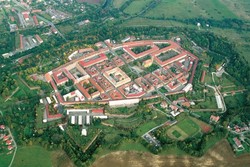Homepage › Landmarks › Fortresses
Baroque fortresses
The area between the Orlické Mountains and the Krkonoše Mountains has always been one of the easiest accesses to otherwise by the mountains surrounded so-called Czech Basin. That is why Armies were crossing it in both directions. The area of the Hradec Králové Region thus became together with the areas of other regions the place of military conflicts

In 1780 Imperial Chamber redeemed the part of the Smiřice Manor and the village Ples and on the 3rd October of the same year at the place of the future Jaroměř Gate, in the presence of the Emperor Josef II., the foundation stone of the military bastion fortress was laid. The fortress was built in the years 1780 to 1787 according to the plans of the French engineer Duhamel de Querlonde above the confluence of the Elbe and Metuje. An extensive underground defense system with a total length of 45 kilometers was the strongest weapon of the imperial fortress, In 1793 it was named after its founder the Emperor Josef. The fortress is one of our most important monuments of military engineering and fortification art in the 18th century.
Due to the strategic location of East Bohemia which was close to the border of the former Austro-Hungarian Empire, the imperial army was looking for a suitable location for setting up another great fortress and crew location. Finally Hradec Králové was chosen and in the last quarter of the 18th century was rebuilt in the military fortress. The construction lasting twenty-five years completely changed the appearance of the town and its surroundings. Not only houses in the construction area were demolished but also extensive suburbs. The fortress encircled the old royal dowry town by walls and forward bastions; inside the walls barracks, headquarters and others were built. The then fortress technique was based on constructing tens of metres wide ramparts and mounds from soil reinforced on the sides by brick walls. When shelling the enemy it would have taken a very long time before the cannons could have completely shot up through the huge mass of walls and open the passage for military attack. Although the fortress after its completion in 1789 presented the excellent technical work, its importance kept declining. Its worthlessness ultimately confirmed the Prussian-Austrian war in 1866, when attacking Prussian troops bypassed and the decisive encounter took place further, in the vicinity of Sadová and Chlum. The role of Hradec Králové as the fortress town thus lost its meaning. It took another fourteen years before the negotiations on walls withdrawal and fortress demolition began which increasingly limited the possible development of the town. After difficult negotiations when Imperial and Royal Army requested the town to demolish and liquidate the walls and to replace the premises to the Army the agreement was finally reached in 1894 and demolition works were solemnly initiated.
Pevnost Josefov (Josefov fortress)
The tourist attraction includes a sightseeing tour of the spectacular underground labyrinths. The atmosphere is intensified by the labyrinths being illuminated by candle light. The trip can be complemented by visiting other casemate areas and in particular the lapidary of the Baroque sculptor M. Braun.
![Hradec Králové Region [logo]](/images/khkrajcr/kralovehradecky-kraj-en.jpg)



